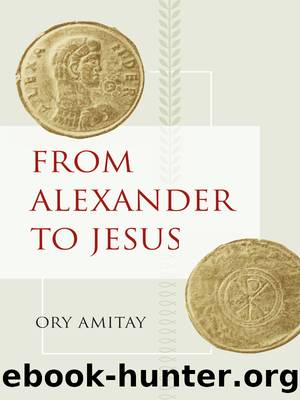From Alexander to Jesus by Amitay Ory;

Author:Amitay, Ory;
Language: eng
Format: epub
Publisher: University of California Press
a While the other versions of the Midrash call God “The sacred One Blessed be He,” Targum Sheni has “The King of Kings, Yhwh of the hosts.”
b That is, the Persian King mentioned in Esther, in all likelihood Xerxes: Ezra 4:4–7, but cf. Josephus, AJ 11.184.
c Covering in haphazard fashion the period between the destruction of the second temple in 70 C.E. and the Umayyad Caliph Hisham Ibn-'Abd-el-Malik (reg. 724-743 C.E.).
d In this version God is not assigned a tenth kingdom but will preside over the day of judgment following a Messianic age lasting two millennia.
The same deduction can be made from the frequency of the various names in the different lists. The King with the greatest number of appearances is clearly the First and Last: eight times under different names. Nimrod and Nebuchadnezzar appear five times each. solomon, Cyrus, Alexander and the Messiah (he, too, with varying titles), four times. Ahab, three. Aashverosh, two. Pharaoh, Israel, Darius, Rome, Caesar-Augustus, Vespasian and Ardashir: a single appearance each. If we assume that the most frequent names belong to the earliest list, the less frequent ones to the later and more idiosyncratic variants, the composition of the list in Pirqei deRabi Eli'ezer appears to support its originality.62
A comparative examination of the arrangement of the various lists leads to a similar conclusion. The array of Kings in Pirqei deRabi Eli'ezer is tight and well organized. Eight human Kings—seven in the past and one still a promise for the future—are sandwiched between the first and the last reigns of God. The competing lists, on the other hand, all seem to be based on the prototype provided by Pirqei deRabi Eli'ezer, while each version manipulates the original set-up in its own peculiar fashion, in order to accommodate the new facts unfurled by the march of history. As we observed above, Targum Sheni omits Ahab to make room for a ninth kingdom—Rome. “Bereshit Rabati” eliminates both Ahab and God's ultimate reign, to make room for Darius (the Mede?) in sixth place, and for Caesar Augustus in ninth. In Aqan deMar Ya'aqov sixth place is occupied by Aashverosh, while God relinquishes both reigns to allow the admittance of Vespasian and Ardashir. De-Rossi 327 employs a different tactic, sticking hard by the original list and opening a gap for new developments (taking up about half of the original text. on the threshold between the spatium historicum and the spatium mythicum—that is, between Alexander and the Messiah.
Having established both the primacy of the list in Pirqei deRabi Eli'ezer and a relatively safe chronological framework for its foundation, we can now turn to examine its historical import. Unfortunately, the wide time gap between Alexander and Pompey (not to mention Vespasian) prohibits any positive assertion concerning the exact historical context of the Midrash, as well as its concrete political and theological aims. The Hellenistic and Roman phases of second temple history form one of the most turbulent chapters in the history of Eretz-Israel, a chapter laced with ardent Messianic aspirations and disappointments.
Download
This site does not store any files on its server. We only index and link to content provided by other sites. Please contact the content providers to delete copyright contents if any and email us, we'll remove relevant links or contents immediately.
| Ancient & Classical | Arthurian Romance |
| Beat Generation | Feminist |
| Gothic & Romantic | LGBT |
| Medieval | Modern |
| Modernism | Postmodernism |
| Renaissance | Shakespeare |
| Surrealism | Victorian |
4 3 2 1: A Novel by Paul Auster(11052)
The handmaid's tale by Margaret Atwood(6856)
Giovanni's Room by James Baldwin(5880)
Big Magic: Creative Living Beyond Fear by Elizabeth Gilbert(4723)
Asking the Right Questions: A Guide to Critical Thinking by M. Neil Browne & Stuart M. Keeley(4576)
On Writing A Memoir of the Craft by Stephen King(4215)
Ego Is the Enemy by Ryan Holiday(3991)
Ken Follett - World without end by Ken Follett(3974)
The Body: A Guide for Occupants by Bill Bryson(3802)
Bluets by Maggie Nelson(3711)
Adulting by Kelly Williams Brown(3671)
Guilty Pleasures by Laurell K Hamilton(3587)
Eat That Frog! by Brian Tracy(3514)
White Noise - A Novel by Don DeLillo(3436)
The Poetry of Pablo Neruda by Pablo Neruda(3367)
Alive: The Story of the Andes Survivors by Piers Paul Read(3312)
The Bookshop by Penelope Fitzgerald(3229)
The Book of Joy by Dalai Lama(3218)
Fingerprints of the Gods by Graham Hancock(3214)
